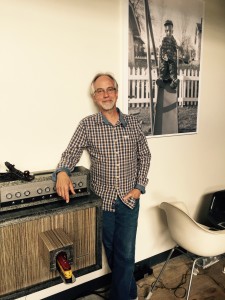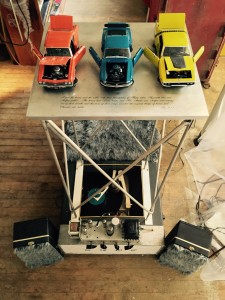sabbatical (n): a break from customary work to acquire new skills or knowledge, traditionally occurring every seventh year
Breaks Away: Sabbatical Stories of Hope
Each academic year, a number of Hope faculty take sabbatical leaves away from the college, submersing themselves for extended periods of time into their favored fields of inquiry. If viewed from above and all together, those fields would look like a calico landscape, so varied and colorful is the topography of their collective research, writing, and creative pursuits. Offering restoration and adventure both, sabbaticals are a bit like information and imagination transfusions. These breaks away from normal classroom and committee work give Hope academicians a boost to reinforce and revitalize their teaching and scholarship.
In foam and clay and metal, from memory and history and spontaneity, the new artworks created by Hope art professor and sculptor Billy Mayer can be best described as pieces of funereal whimsy. Come January 2016, when his one-man show, “440,” opens in the DePree Art Gallery, it will be easy to see why.

During his sabbatical leave to San Marcos, Texas, on the campus of Texas State University – where his wife, Michel Conroy, is also a professor of art – Mayer went to work to “riff on” subjects mostly from his youth. His love of rock-and-roll, fascination with the early NASA lunar missions and pull to Michigan’s automotive history are topics for his sculpture, broached in lightness but with somber undertones.
“I believe I agree with (former Hope colleague) Pinckney Benedict who said much of his creative work, and my creative work too, conveys memories and feelings from the first 10 years of life,” Mayer explains. “It was a time when few filters – either from self or society – were imposed on us. We played non-judgmentally. We were untainted sponges. John Glenn was as important to me then as was my guitar. And that has stayed beautifully lodged in my brain.”
And now into clay and other media, too. Those memories and their resulting emotions will be on display in his art exhibition entitled “440,” chosen by Mayer as a nod to his 440 ceramic, mini-skulls with various, odd objects attached (200 new and 240 from other Mayer shows) as well as the short-wave frequency to which all music is tuned.
One of the works in his new show conjures up surrealist Rene Magritte’s “Time Transfixed” and displays Mayer’s playful focus on music and youth. With a carved wooden train emerging from the glittery weave of a sculpted foam guitar amplifier, the piece harkens back to Mayer’s teen years and his love of model trains, and that guitar again, while also pointing to his sense of present place. He is neighborly, after all, with trains running the tracks just outside his DePree Center studio.
“Clay is like a child. You can’t walk away from it for too long. It moves; it cracks. You have to constantly tend to it.” — Billy Mayer
Other artwork – like “The Second Assassination of Chief Pontiac” and “Revelation 9:17” – unveil an artist who creates in ways that simultaneously display the mutability of language and the malleability of clay. Through word and material play, Mayer’s eloquence reveals itself, for in “440,” the gallery-goer will find sculpted works that “riff” some more and speak to ISIS, John Boehner and medical marijuana as well.

“The English language is organic,” Mayer says. “I love etymology and how one word can morph into multiple meanings, one phrase can mean much… As for clay, it is like a child. You can’t walk away from it for too long. It moves; it cracks. You have to constantly tend to it.”
While in Texas, Mayer also visited Marfa, a west Texas desert town noted for its unique art filling fields and streets and home to the Donald Judd Foundation. Trips to the National Council on Education in the Ceramic Arts in Providence, Rhode Island, and museums and galleries in Washington, DC, were all part of his itinerary and provided space for refreshment and inspiration.
“What I appreciate most about sabbaticals is the ability to focus on my own work uninterrupted,” Mayer concludes.
Because when he does, it turns out he has a lot to do and say. Well, at least in 440 ways.
—
Billy Mayer is a professor in the Art and Art History Department at Hope College.

